
Deposition Date
2017-11-21
Release Date
2018-01-24
Last Version Date
2023-10-04
Entry Detail
PDB ID:
6BP1
Keywords:
Title:
Crystal structure of human KRAS A59G mutant in complex with GCP
Biological Source:
Source Organism:
Homo sapiens (Taxon ID: 9606)
Host Organism:
Method Details:
Experimental Method:
Resolution:
2.00 Å
R-Value Free:
0.22
R-Value Work:
0.20
R-Value Observed:
0.20
Space Group:
P 21 21 21


